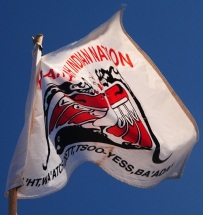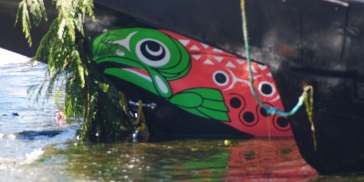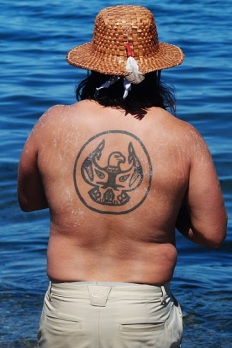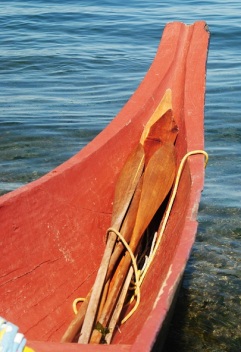 As I looked out from the beach in West Seattle, they appeared as specks on the horizon. But as they inched closer, if I looked hard enough, I could see their paddles undulating in unison. They made me think of Viking ships with dozens of long wooden oars pushing the boat through the sea.
As I looked out from the beach in West Seattle, they appeared as specks on the horizon. But as they inched closer, if I looked hard enough, I could see their paddles undulating in unison. They made me think of Viking ships with dozens of long wooden oars pushing the boat through the sea.

They were coming! Suquamish, Makah, Swinomish, Jamestown S’Klallam, Squaxin, Cowichan, Quileute and many more tribal members participating in the annual canoe journey in the Northwest.
 This year’s celebration, the Paddle to Nisqually, journeyed to the Nisqually Tribe’s lands near Olympia in July. But first, the paddlers converged at Alki Beach in West Seattle, to be welcomed by representatives of the Muckleshoot Tribe, on whose territory they had landed.
This year’s celebration, the Paddle to Nisqually, journeyed to the Nisqually Tribe’s lands near Olympia in July. But first, the paddlers converged at Alki Beach in West Seattle, to be welcomed by representatives of the Muckleshoot Tribe, on whose territory they had landed.
More than 70 canoes from Washington and Canada were making their way on a physical and spiritual journey. From Seattle, the canoes would travel over Puget Sound to the tribal lands of the Nisqually, hosts for this year’s cultural ceremony.
 The annual event is held at a different location each year, and has a common goal of “providing a drug and alcohol free event and offering pullers a personal journey towards healing and recovery of culture, traditional knowledge and spirituality.”
The annual event is held at a different location each year, and has a common goal of “providing a drug and alcohol free event and offering pullers a personal journey towards healing and recovery of culture, traditional knowledge and spirituality.”


 In the past, canoes have even carried Native Hawaiians, Inuit and Maori to the tribal ceremony. It’s hard to imagine human beings paddling across an ocean. Of course, they have support boats accompanying them, and change paddlers to provide rest during the journey. But still!
In the past, canoes have even carried Native Hawaiians, Inuit and Maori to the tribal ceremony. It’s hard to imagine human beings paddling across an ocean. Of course, they have support boats accompanying them, and change paddlers to provide rest during the journey. But still!
 As the canoes arrived at the beach, the paddlers pulled them ashore, temporarily. Then, as more participants arrived, they went back into the water and paddled around together. I understood that this was part of the tradition.
As the canoes arrived at the beach, the paddlers pulled them ashore, temporarily. Then, as more participants arrived, they went back into the water and paddled around together. I understood that this was part of the tradition.




 After a few
After a few dozen canoes had arrived, the crews assembled close to the beach, lining up the boats and sitting with their paddles held straight up. They waited to be welcomed ashore.
dozen canoes had arrived, the crews assembled close to the beach, lining up the boats and sitting with their paddles held straight up. They waited to be welcomed ashore.









 Each canoe asked permission from the Muckleshoot Tribe, hosts for this part of the journey. Women of the Muckleshoots then spoke to each canoe in turn, speaking in their language and beating a small drum.
Each canoe asked permission from the Muckleshoot Tribe, hosts for this part of the journey. Women of the Muckleshoots then spoke to each canoe in turn, speaking in their language and beating a small drum.

As each canoe was welcomed, the paddlers pulled it ashore and carried it up onto the land for the night. Men, women and teens helped shoulder the load. The authentic dugout canoes looked pretty heavy!
The participants welcomed outsiders to witness their journey, admire their canoes and chat with them. I met a woman who came from Neah Bay, all the way at the western tip of the state. I had visited Neah Bay years ago, and recalled its beauty and wonderful smoked salmon!

 I enjoyed checking out their canoes, many with native paintings and words. Some paddles also had native art, and many canoes flew flags of their tribes.
I enjoyed checking out their canoes, many with native paintings and words. Some paddles also had native art, and many canoes flew flags of their tribes.
 It was inspirational to see such a large group of people, coming together to celebrate and strengthen their cultures and community, and in many cases to restore their own well-being along the way.
It was inspirational to see such a large group of people, coming together to celebrate and strengthen their cultures and community, and in many cases to restore their own well-being along the way.
 I hope the rest of their journey was peaceful.
I hope the rest of their journey was peaceful.









Looks like a great ceremony, Joan, and I appreciated all the interesting detail you inserted about the different tribes, traditions, etc., and your colorful photos. (BTW I used to go canoeing as a kid when I went to summer camp on White Lake — same lake on which Woodstock took place, I’ll insert — so thanks for bringing back that memory too.)
LikeLiked by 1 person
Thank you! Glad you enjoyed it. I made sure to describe it as a “ceremony” rather than a festival, which I read on their website. So, the entire 5 days or so of events is considered a ceremony.
LikeLiked by 1 person
Very cool! What great pictures and loved the background. Lulu and I need to study this further. BUT, we decided that you should get a back tattoo, for sure.
LikeLiked by 1 person
Wonderful pictures along with your story. The dugouts have to be heavy…I rowed 8-person shell. We had to carry the old wooden practice shell, lifting it from the boathouse rack and taking it to the river, until we were good enough for the light, fast fiberglass one.
Love the artwork too on the canoes.
LikeLike
Thanks! Yes, the wooden ones looked very heavy. There was at least one that wasn’t wood, though. Maybe fiberglass?
LikeLike